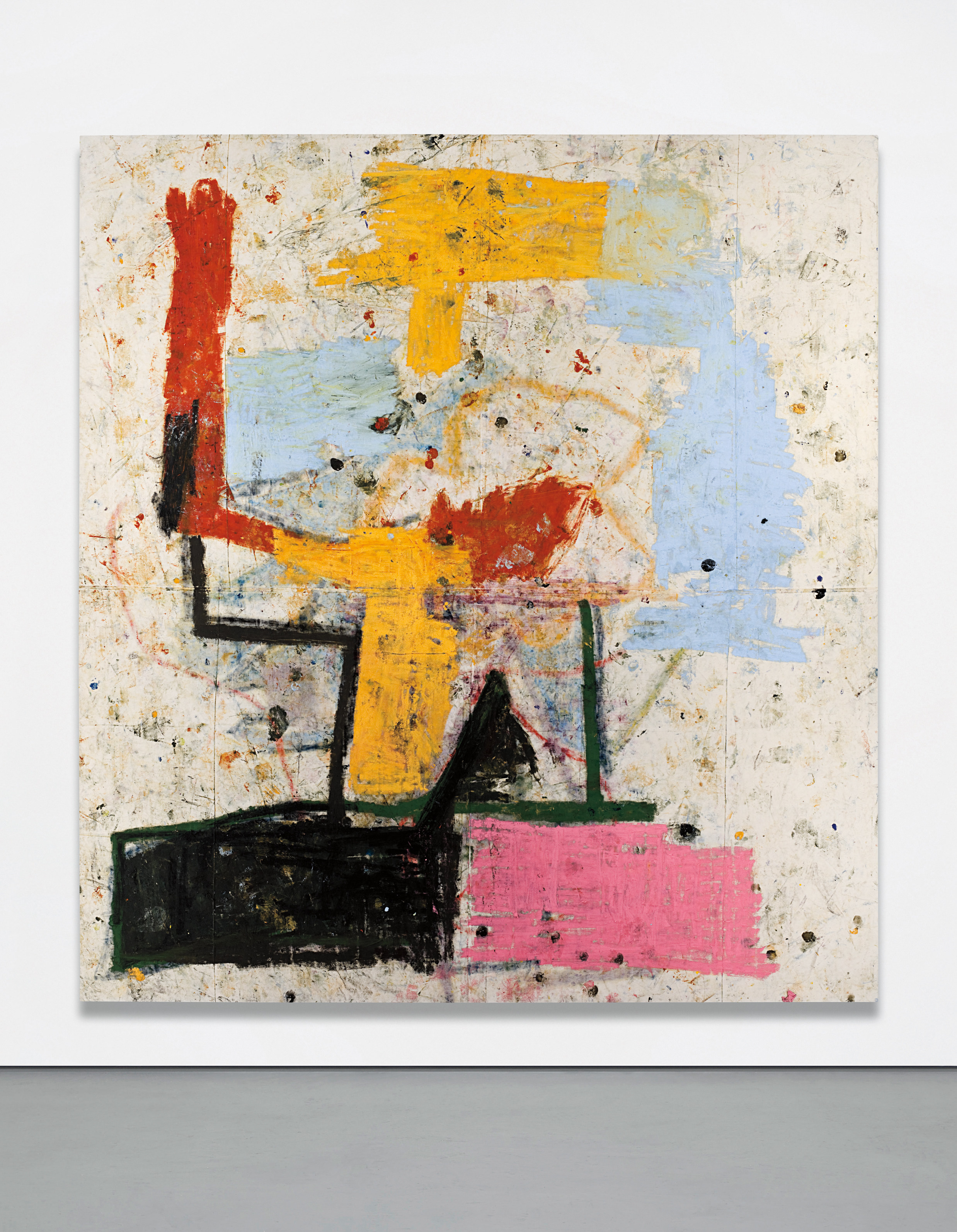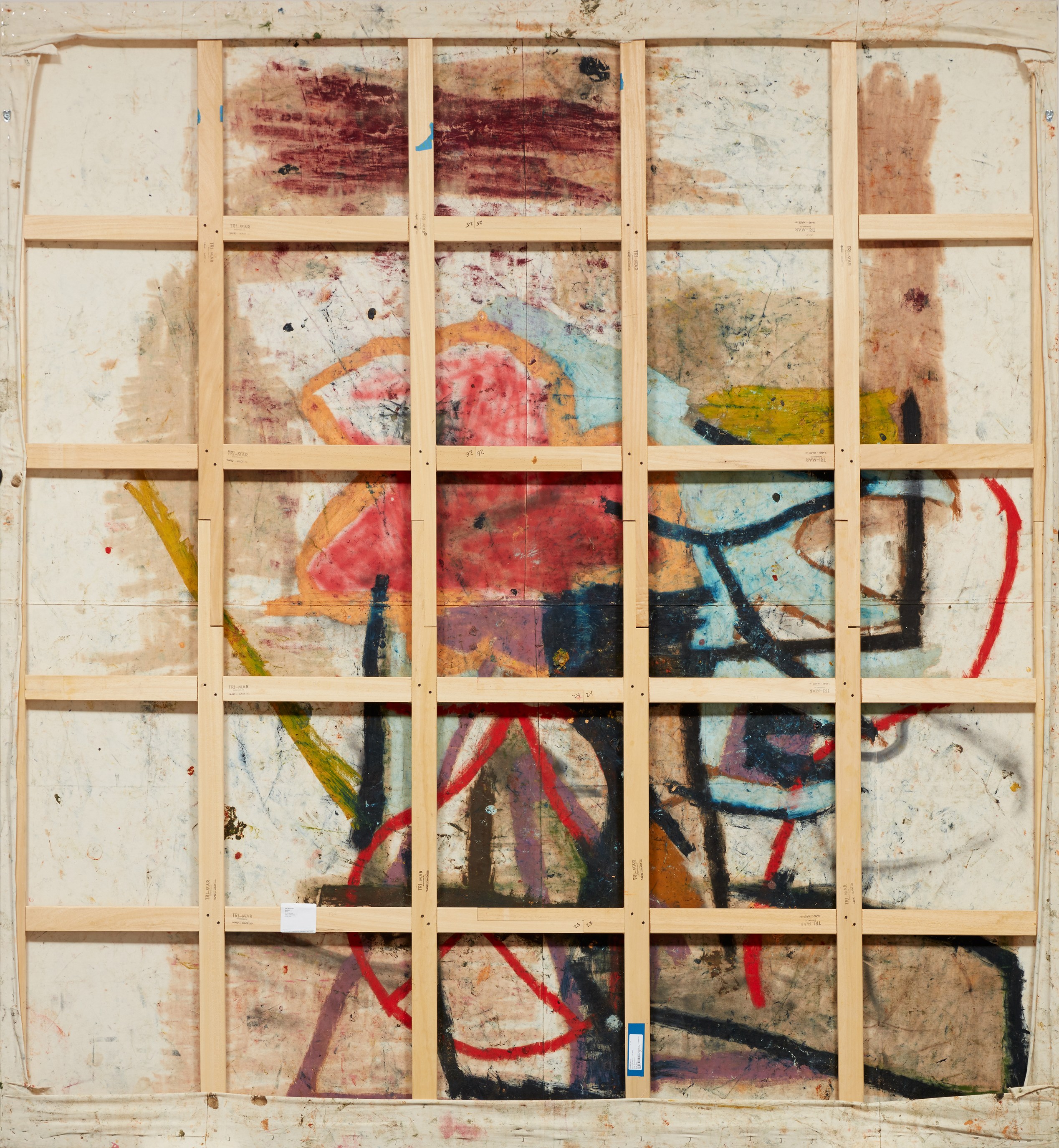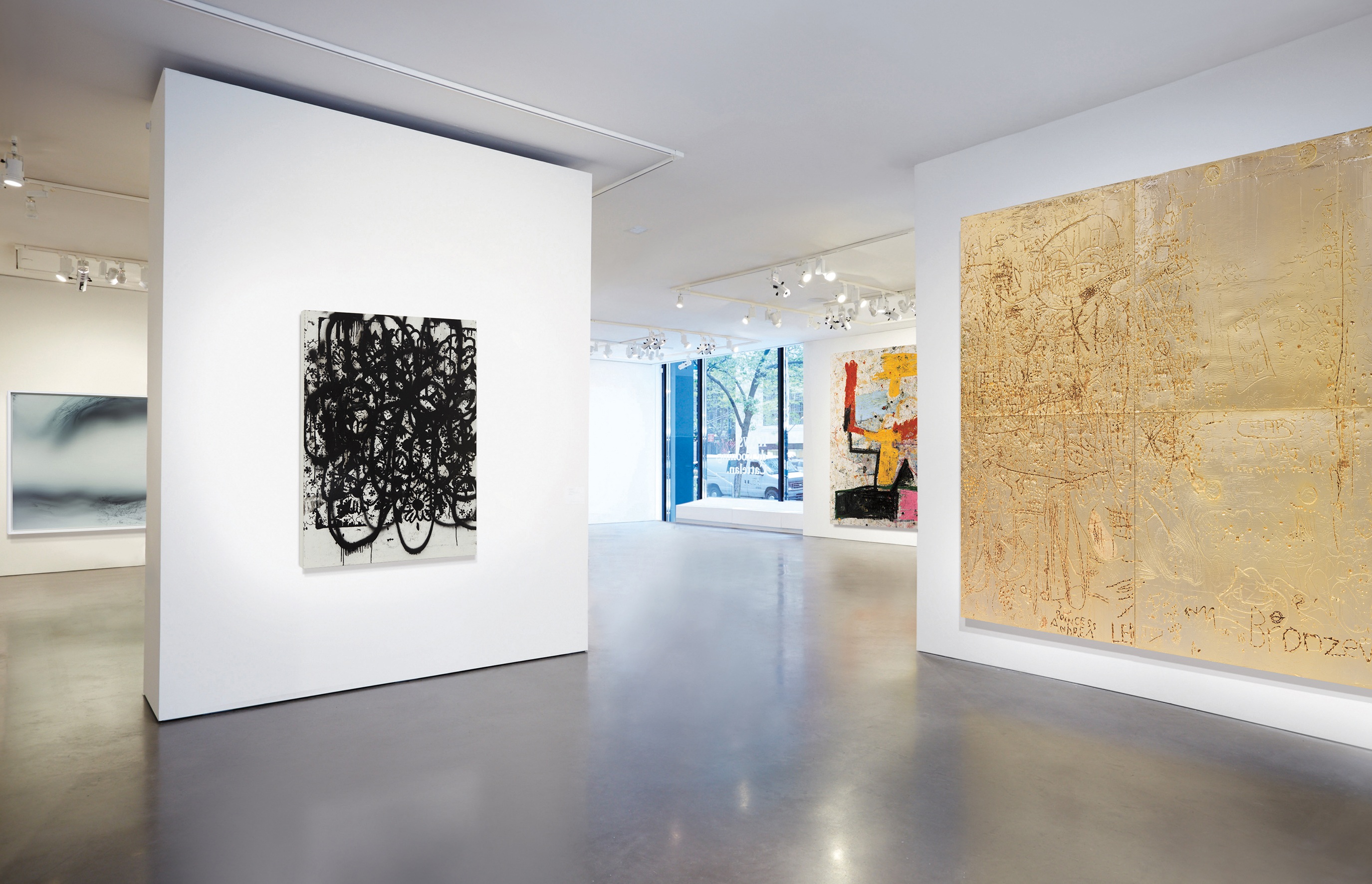





37
Joe Bradley
Big Boy
- Estimate
- $800,000 - 1,200,000
$700,000
Lot Details
oil, oilstick, grease and studio detritus on joined canvas
signed and dated "2010 Joe Bradley" on the overlap
130 x 120 in. (330.2 x 304.8 cm.)
Executed in 2010.
Specialist
Full-Cataloguing
Catalogue Essay
Towering above the viewer with its sheer monumentality, Big Boy is an enthralling painting from one of Joe Bradley’s most coveted series that is currently in focus at the artist’s major touring mid-career retrospective starting at the Albright-Knox Art Gallery, Buffalo, New York. Abstract elements of bright, unmodulated color and flurries of graffiti-like lines coalesce into figuration across the vast canvas. Marked with paint splatter, footprints and visible grid-like creases, the canvas acts as testament to the artist’s signature technique of handling the unprimed canvas on the studio floor. Evoking Jean-Michel Basquiat’s pictorial idiom, Big Boy presents the viewer with a totemic stick figure whose outstretched arm recalls the hamburger-bearing mascot of the “Big Boy” food chain. Executed in 2010, two years after Bradley’s critical breakthrough at the Whitney Biennial, New York, this painting debuted in the artist’s seminal solo exhibition Mouth and Foot Painting at Gavin Brown’s enterprise in 2011. Representing a major shift in the New York-based artist’s practice, Big Boy thereby belongs to the sought-after series of charged all-over canvases that distinguished themselves with their large scale and their introduction of the medium of oil paint for the first time since his early modular work. With its impressive scale, dynamic composition and palpable immediacy, Big Boy finds its match only in Strut, 2010, a painting from the same series that The Museum of Modern Art, New York, added to its permanent collection in 2011. Indeed, as Bradley acknowledged, “as for ‘Big Boy’ and ‘Strut’, it’s fun to paint at that scale. It’s a challenge” (Joe Bradley, quoted in Phong Bui, ‘Joe Bradley’, Brooklyn Rail, February 3, 2011, online). Not only is Big Boy the largest canvas Bradley had hitherto created, it also distinguished itself within the series as the most explicit in its reference to the human figure.
Within a little more than a decade since his first solo exhibition, Bradley has established himself as one of the most important painters of his generation. Drawn to open-ended situations and a mutable approach to art making in a manner that recalls his artistic forebears Francis Picabia or Martin Kippenberger, he famously eschews a singular style or subject matter - working in distinct, often concurrent, series that pivot back and forth between abstraction and figuration, and the comic and the earnest, with a sly nod to the eclectic history of 20th century painting. The series of densely layered abstract paintings to which Big Boy belongs represent the culmination of two bodies of works that garnered the artist critical acclaim after his inclusion in the 2008 Whitney Biennial, New York. The configuration of blocks of black, yellow, pink, crimson and blue paint harken back to the pairings of modular “robot” color field paintings Bradley has been creating since around 2004, while the distilled stick figure can be considered a development from the semi-figurative graphic forms of the Shmagoo grease-pencil drawings on canvas from 2008 to 2009. Many of Bradley’s seemingly abstract compositions bear some connection to the human form and in this body of work they specifically invoke a range of fictional characters, referring to the mascot of the fast food chain with Big Boy, the character from the cartoon Peanuts with Pig Pen, or the novel by American science fiction author Philip K. Dick in Museum of Modern Art’s painting Strut.
“With painting, I always get the feeling that you’re sort of entering into a shared space”, Bradley mused, “There’s everyone who’s painted in the past, and everyone who is painting in the present” (Joe Bradley, quoted in Laura Hoptman, “Joe Bradley”, Interview Magazine, June 2014, online). Big Boy epitomizes Bradley’s sophisticated engagement with the history of abstraction, its weathered textures and bold lines paying homage to the legacies of such painters as Jackson Pollock, Willem de Kooning, Jean Dubuffet, Jean-Michel Basquiat, Philip Guston and Cy Twombly. And yet, as Bradley explained, while he does naturally absorb these art historical influences, ultimately “the idea is to sublimate that in the work and to come up with something that feels and looks like your own” (Joe Bradley, quoted in Eric Troncy, ‘Joe Bradley — interview by Eric Troncy’, Frog Magazine, issue 14, online).
Despite the stylistic diversity of his practice, Bradley’s unique sensitivity to materials and emphasis on the union of color and surface permeates throughout. Perfectly exemplifying Bradley’s process-oriented approach to painting, Big Boy is the result of a methodological and prolonged painting process that often takes several months to complete. Addressing the physicality of the two-dimensional surface, Bradley topples the hierarchy of painting by taking it down from its pristine pedestal and literally throwing it onto the ground – working directly after a drawing or a found source image on an unstretched, unprimed cotton canvas that he lays out on the studio floor, folds, rolls, stacks and flips, before eventually tacking the canvas to the wall and ultimately stretching it on a frame. Accumulating indexical marks of Bradley’s multi-layered process, the canvas is intentionally meant to pick up dirt and debris, footprints, smudges, handprints and paint splatter. This notion of “building damage into the work”, something that has interested Bradley throughout his practice, pulls the viewer’s attention away from the imagery to the very materiality of the painting. With a sly nod to the legacy of Jackson Pollock, who famously wrote about the sensation of being “in” his paintings, Bradley explained his process as follows: “You need one foot on turf, on land, and one foot in the cosmos” (Joe Bradley, quoted in “Joe Bradley and Chris Martin”, The Journal, Fall 2009, n.p.). A sheer tour-de-force, Big Boy is without a doubt one of the best examples of Bradley’s celebrated process-based approach to painting and speaks to simultaneously his investment in the earnest and the comic, the abstract and the figurative.
Within a little more than a decade since his first solo exhibition, Bradley has established himself as one of the most important painters of his generation. Drawn to open-ended situations and a mutable approach to art making in a manner that recalls his artistic forebears Francis Picabia or Martin Kippenberger, he famously eschews a singular style or subject matter - working in distinct, often concurrent, series that pivot back and forth between abstraction and figuration, and the comic and the earnest, with a sly nod to the eclectic history of 20th century painting. The series of densely layered abstract paintings to which Big Boy belongs represent the culmination of two bodies of works that garnered the artist critical acclaim after his inclusion in the 2008 Whitney Biennial, New York. The configuration of blocks of black, yellow, pink, crimson and blue paint harken back to the pairings of modular “robot” color field paintings Bradley has been creating since around 2004, while the distilled stick figure can be considered a development from the semi-figurative graphic forms of the Shmagoo grease-pencil drawings on canvas from 2008 to 2009. Many of Bradley’s seemingly abstract compositions bear some connection to the human form and in this body of work they specifically invoke a range of fictional characters, referring to the mascot of the fast food chain with Big Boy, the character from the cartoon Peanuts with Pig Pen, or the novel by American science fiction author Philip K. Dick in Museum of Modern Art’s painting Strut.
“With painting, I always get the feeling that you’re sort of entering into a shared space”, Bradley mused, “There’s everyone who’s painted in the past, and everyone who is painting in the present” (Joe Bradley, quoted in Laura Hoptman, “Joe Bradley”, Interview Magazine, June 2014, online). Big Boy epitomizes Bradley’s sophisticated engagement with the history of abstraction, its weathered textures and bold lines paying homage to the legacies of such painters as Jackson Pollock, Willem de Kooning, Jean Dubuffet, Jean-Michel Basquiat, Philip Guston and Cy Twombly. And yet, as Bradley explained, while he does naturally absorb these art historical influences, ultimately “the idea is to sublimate that in the work and to come up with something that feels and looks like your own” (Joe Bradley, quoted in Eric Troncy, ‘Joe Bradley — interview by Eric Troncy’, Frog Magazine, issue 14, online).
Despite the stylistic diversity of his practice, Bradley’s unique sensitivity to materials and emphasis on the union of color and surface permeates throughout. Perfectly exemplifying Bradley’s process-oriented approach to painting, Big Boy is the result of a methodological and prolonged painting process that often takes several months to complete. Addressing the physicality of the two-dimensional surface, Bradley topples the hierarchy of painting by taking it down from its pristine pedestal and literally throwing it onto the ground – working directly after a drawing or a found source image on an unstretched, unprimed cotton canvas that he lays out on the studio floor, folds, rolls, stacks and flips, before eventually tacking the canvas to the wall and ultimately stretching it on a frame. Accumulating indexical marks of Bradley’s multi-layered process, the canvas is intentionally meant to pick up dirt and debris, footprints, smudges, handprints and paint splatter. This notion of “building damage into the work”, something that has interested Bradley throughout his practice, pulls the viewer’s attention away from the imagery to the very materiality of the painting. With a sly nod to the legacy of Jackson Pollock, who famously wrote about the sensation of being “in” his paintings, Bradley explained his process as follows: “You need one foot on turf, on land, and one foot in the cosmos” (Joe Bradley, quoted in “Joe Bradley and Chris Martin”, The Journal, Fall 2009, n.p.). A sheer tour-de-force, Big Boy is without a doubt one of the best examples of Bradley’s celebrated process-based approach to painting and speaks to simultaneously his investment in the earnest and the comic, the abstract and the figurative.
Provenance
Exhibited
Literature